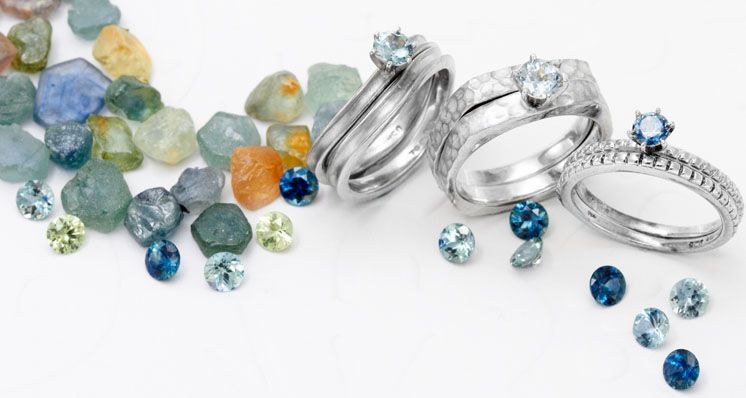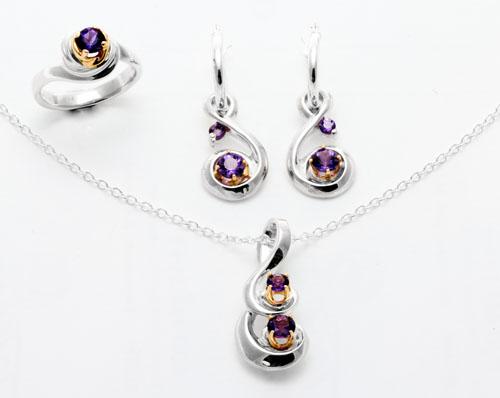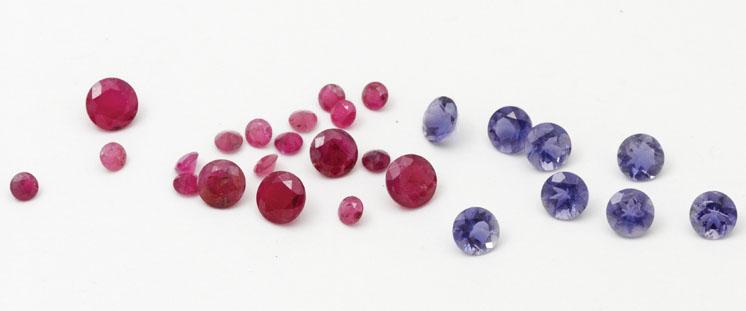
Columbia Gem House president, Eric Braunwart, explores the growing popularity of American gemstones and discusses the importance of traceability, ethical sourcing and the millennial consumer with Sarah Jordan.
American company Columbia Gem House has been steadily building a mine-to-market supply chain for ethically sourced gemstones since 1976. Its business spans mines and cutting facilities on three continents, with the manufacture of finished jewellery taking place in the United States. Its vertically integrated business model, emphasis on corporate social responsibility practices, and impressive traceability make it one of the most thorough gemstone companies operating today.
A Small Company with Big Ideas
Eric Braunwart, president of Columbia Gem House and the business’ finished jewellery brand, Trigem Designs, is exactly the character you would expect to discover, behind the company; knowledgeable, engaged and enthusiastic, not just about his own trade, but also the wider industry. “There are great benefits and great draw backs,” Braunwart admits about the vertically-integrated nature of his business, which follows gemstones from mine, to cutting facilities, to finished jewellery and through the end-consumer marketing process. “It is very unusual, we are one of the few or the only one I know of that is [vertically integrated]. It is hard to do because you have to have expertise in rough, in cutting, wholesaling, but also in jewellery manufacturing. You’re also distributing to two different audiences, as people who buy loose gemstones are not the same as those who buy finished jewellery. This splits your marketing efforts, which is not a wise thing for small companies…and we’re a small company.”

Eric Braunwart, Columbia Gem House president.
Aside from its ambitious, ‘think big’ approach, Columbia Gem House is perhaps best known for its CSR policies and ethical supply chain. Braunwart admits he has developed a sixth sense for treated and synthetic gemstones sneaking into the supply chain, noting: “If we are working with rough, usually but not always we can tell synthetic from natural. It is just 40 years of gut feeling.”
He continues: “We are working to sell American gemstones into China and one of the people we are working with said, ‘I don’t think you can compete because other places do things so much cheaper’. I said they are not cheaper if they are selling the same thing — they are cheaper if they are cheating.”
Read more: Exploring Inclusions in a Twelve Point Black Star Sapphire
When a gemstone is heat-treated, for example, Columbia Gem House has followed that particular parcel from the mine so they know exactly what they are delivering to their customers. Braunwart is bursting with gemstone horror stories, like an acquaintance with two 14 ct and 10 ct yellow sapphires that turned out to be an outright synthetic and a beryllium diffused yellow respectively. The owner believed them to be worth US $16,000, with the real value closer to US $400. “If you are not dealing with the whole process, number one, your product integrity is really in question and, number two your CSR issues are also in question.”
Braunwart believes the situation is only worsening, hinting at the rise of ‘previously unheard of’ testing laboratories and more sophisticated technologies making synthetics even less detectable. Although testing is crucial, Columbia Gem House believes chain of custody is the vital ingredient to banish many of these issues.
To demonstrate his point, Braunwart begins to explain a tense situation that, although starting as a negative, quickly became a positive for his company. He explains: “There is a really important, top-of-the-line jeweller we sell to and we were cutting a certain kind of stone for them. We were short, we went outside our normal supply chain, and one parcel of rough turned out to be bad. I had to call the company and explain that the problem was ‘this’ shipment and I think you could have as many as 87 stones – not synthetic – but they are not black spinel, they are augite, which looks like black spinel.”

Arizona Amethyst.
The jeweller tested every stone and discovered, as per Columbia Gem House’s information, that 83 stones in a particular parcel were augite. “They came back and said, if you can really trace your products that well, you can have as much business as we can give you. It worked in our favour. I would say that 99.8% of suppliers can’t do this,” Braunwart explains.
It is not just product integrity, but product origin, that Columbia Gem House has strict rules on. With their peridot supplies, inventory is separately labelled depending on its region of origin, for example Arizona, China and Pakistan. “People say this is crazy — they all look the same and nobody can tell the difference. But if [a jeweller or brand is] telling the story of an American peridot, and they do a big promotion, if somebody decides to check and the consumer finds out it is a Chinese peridot…10 years ago maybe there would be a letter to the editor in the newspaper and you are trashed in front of 200 people. Now, this can be put on the internet and you can be trashed by 200,000 in an hour.”
Branding Gemstones
The rise of mass forms of communication and the millennial consumer is also an area of fascination for Columbia Gem House. Despite reports from the Jewelers Board of Trade in the United States signalling that retail jewellers, manufacturers and wholesalers are closing, Braunwart argues it is the “old jewellery industry” that is shrinking, because “the new jewellery industry has never heard of the Jewelers Board of Trade”. He continues: “We got more new accounts in the last two months that we have got in the last five years and they are all under 30.”
Columbia Gem House has also turned its attention to branding, capitalising on the lack of visible branding in the gemstone industry to set its own rules. Its trademarked Nyala Ruby, from Chimwadzulu Hill in Malawi, an Tashmarine (a type of brilliant yellowishgreen diopside) gemstones, allow the company to control the reputation and parameters of its offer and challenge those who attempt to use the names without permission. Braunwart comments: “Tashmarine is from a certain location, a certain mountain range and is a certain colour — it always meets these parameters. Why? Because we have a trademark and under this name we have some control. Without this branding we would not have that control.”
“My generic comparison is rhodolite garnet. What I call ‘Japanese rhodolite garnet’ sells for US $80 per carat, but what I call the ‘home shopping network’ garnet sells for US $5 a carat — but they are both called rhodolite even though they don’t look anything the same. The name rhodolite has been bastardised because there is nobody who can control what is sold as rhodolite garnet. I believe that branding is part of traceability and product integrity. It goes hand-in-hand with provenance.”

American Gems Opaques.
Columbia Gem House admits that branding gemstones in this way is not an overnight fix; it has been 40 years in the making. “It is tricky and lots of people say you can’t do it,” Braunwart admits, “but with hard work you can and it is where our industry is going.”
Branding, traceability and ethics all tie into the changing tastes of consumers, in particular idealistic, yet practical, millennials who want it all; great prices, great branding and complete fairness. Many customers under the age of 35 have come to expect a story around their products, whether a quick history or a complete branded marketing campaign. To ensure these stories are positive, Columbia Gem House pursues rigorous CSR requirements from its suppliers at all points in the chain.
Read more: Ruby and Pink Sapphire from Aapaluttoq, Greenland
Montana Sapphires and American Gemstones
One of the biggest success stories to emerge from this year’s Tucson shows was American gemstones, especially Montana sapphires. Columbia Gem House has been busy promoting more than 50 varieties of American gemstones for years, but it has seen a particular surge in recent months. Braunwart says: “For years Arizona was the prime source for peridot and turquoise worldwide and nobody ever said anything about it. We always did because we thought the story was as important as the product, and now that is really coming true.”

Supporting miners and their families in Malawi.
So, why are American gemstones having a moment? Braunwart believes it is, in part, due to the political climate in the United States and the nationalistic sentimentality swept in by President Trump. “Some of the people that are contacting us, some companies that are iconic American companies, don’t have a lot of American products in their stores,” he notes. The second reason is due to the millennial consumer, who is shopping in a completely different way to their parents’ and grandparents’ generations. Instead of gravitating to big advertising campaigns, the majority of under-35s are willing to be more experimental and tend to shy away from the more ‘traditional’ gemstone colours. “Millennials have decided they like green or teal coloured sapphires. If you go through a traditional old jewellery store, there is not one green or teal coloured sapphire. But if you go to Etsy, I would bet there are 5,000 teal or green coloured sapphires on there because [Etsy] is going to millennials and the old market is going to Baby Boomers.”
Another reason for the rise in popularity of Montana sapphires is purely practical — production and marketing are both in stronger positions. In the 30-years that it has cut sapphires from the state, Columbia Gem House has found them tricky to sell, largely because of the ‘unusual’ colours and the necessity of heat treatment. Braunwart says: “Traditionally, 15% come out really nice blues. The rest would come out teals, greens or grey-ish or fancies, yellow, orange and very few pinks. Now two things have happened; there has been far better heat treating systems developed, of which we have the best in the world for Montana sapphires. The colours we get we’re not doing anything except heat [treatments]. Secondly, 10 years ago we could sell 15-20% of the colours and now we can sell everything […] they are all going to millennials and 80% are going into wedding rings.”
Read more: The Tale of the Mouawad-Tereschenko Blue Diamond
The Future of Columbia Gem House
Columbia Gem House is not content to simply rest on its laurels. With numerous, potentially business-changing projects in the pipeline, Braunwart believes if some of these partnerships go ahead, other jewellery businesses will be inspired to follow suit. This domino-effect is what Columbia Gem House is crossing its fingers for, not just for itself, but for the industry as a whole. Braunwart concludes: “We have felt like we were on that tipping points a number of times in the past four or five years and it hasn’t happened. But it does look like it might now… that would be great.” ■

Wyoming ruby & lolite.
Interested in finding out more about gemmology? Sign-up to one of Gem-A’s courses or workshops.
If you would like to subscribe to Gems&Jewellery and The Journal of Gemmology please visit Membership.
Cover image Montana Sapphire Group.
{module Blog Articles Widget}


